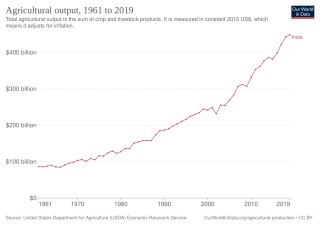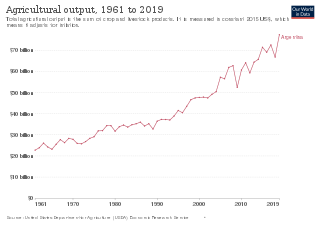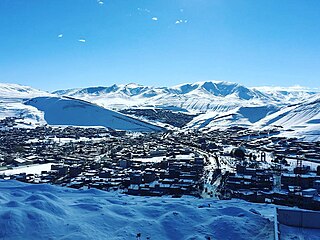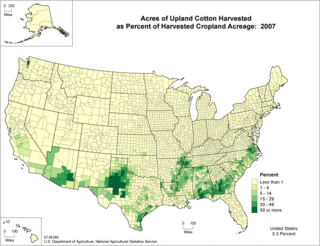
The economy of Mali is based to a large extent upon agriculture, with a mostly rural population engaged in subsistence agriculture.

Cotton is a soft, fluffy staple fiber that grows in a boll, or protective case, around the seeds of the cotton plants of the genus Gossypium in the mallow family Malvaceae. The fiber is almost pure cellulose, and can contain minor percentages of waxes, fats, pectins, and water. Under natural conditions, the cotton bolls will increase the dispersal of the seeds.

The cocoa bean or simply cocoa, also called cacao, is the dried and fully fermented seed of Theobroma cacao, from which cocoa solids and cocoa butter can be extracted. Cocoa beans native to the Mexican pre Colombian territory were extended to Ecuadorian Amazon rainforest and are the basis of chocolate and Mesoamerican foods including tejate, an indigenous Mexican drink.

Agdash District is one of the 66 districts of Azerbaijan. It is located in the centre of the country and belongs to the Central Aran Economic Region. The district borders the districts of Yevlakh, Shaki, Oghuz, Qabala, Goychay, Ujar, Zardab, and Barda. Its capital and largest city is Agdash. As of 2020, the district had a population of 111,100.

Agriculture in Thailand is highly competitive, diversified and specialized and its exports are very successful internationally. Rice is the country's most important crop, with some 60 percent of Thailand's 13 million farmers growing it on almost half of Thailand's cultivated land. Thailand is a major exporter in the world rice market. Rice exports in 2014 amounted to 1.3 percent of GDP. Agricultural production as a whole accounts for an estimated 9–10.5 percent of Thai GDP. Forty percent of the population work in agriculture-related jobs. The farmland they work was valued at US$2,945/rai in 2013. Most Thai farmers own fewer than eight ha (50 rai) of land.

The history of agriculture in India dates back to the Neolithic period. India ranks second worldwide in farm outputs. As per the Indian economic survey 2020 -21, agriculture employed more than 50% of the Indian workforce and contributed 20.2% to the country's GDP.

Agriculture is one of the bases of Argentina's economy.

Germi County is in the northern part of Ardabil province, Iran. Its capital is the city of Germi, located 110 km (68 mi) from Ardabil, the capital of the province.

Tajikistan is a highly agrarian country, with its rural population at more than 70% and agriculture accounting for 60% of employment and around 20% of GDP in 2020. As is typical of economies dependent on agriculture, Tajikistan has a low income per capita: Soviet Tajikistan was the poorest republic with a staggering 45% of its population in the lowest income “septile”. In 2006 Tajikistan still had the lowest income per capita among the Commonwealth of Independent States (CIS) countries: $1,410 compared with nearly $12,000 for Russia. The low income and the high agrarian profile justify and drive the efforts for agricultural reform since 1991 in the hope of improving the population's well-being.

The cultivation of tobacco usually takes place annually. The tobacco is germinated in cold frames or hotbeds and then transplanted to the field until it matures. It is grown in warm climates with rich, well-drained soil. About 4.2 million hectares of tobacco were under cultivation worldwide in 2000, yielding over seven million tonnes of tobacco.

In New Zealand, agriculture is the largest sector of the tradable economy. The country exported NZ$46.4 billion worth of agricultural products in the 12 months to June 2019, 79.6% of the country's total exported goods. The agriculture, forestry and fisheries sector directly contributed $12.653 billion of the national GDP in the 12 months to September 2020, and employed 143,000 people, 5.9% of New Zealand's workforce, as of the 2018 census.
China Cotton Association (CCA) is a Chinese non-profit federation specializing in cotton, which is voluntarily established by cotton farmers, cotton farmers' cooperative organizations, enterprises engaged in cotton production, purchase, processing and operation, cotton textile enterprises, cotton research institutes and other organs and which accepts the supervision and management of the Chinese Ministry of Civil Affairs and the professional guidance of the All-China Federation of Supply and Marketing Cooperatives.

The role of agriculture in the Bolivian economy in the late 1980s expanded as the collapse of the tin industry forced the country to diversify its productive and export base. Agricultural production as a share of GDP was approximately 23 percent in 1987, compared with 30 percent in 1960 and a low of just under 17 percent in 1979. The recession of the 1980s, along with unfavorable weather conditions, particularly droughts and floods, hampered output. Agriculture employed about 46 percent of the country's labor force in 1987. Most production, with the exception of coca, focused on the domestic market and self-sufficiency in food. Agricultural exports accounted for only about 15 percent of total exports in the late 1980s, depending on weather conditions and commodity prices for agricultural goods, hydrocarbons, and minerals.
The primary crops produced in Azerbaijan are agricultural cash crops, grapes, cotton, tobacco, citrus fruits, and vegetables. The first three crops account for over half of all production, and the last two together account for an additional 30 percent. Livestock, dairy products, and wine and liquors are also important farm products.

Azerbaijani wine is produced in several regions throughout Azerbaijan. Prior to 20th century communist rule, the region which makes up modern-day Azerbaijan had a thriving wine industry that dated back to the second millennium BC. Azerbaijan's long history of wine production was rediscovered at archaeological digs of settlements in Kültəpə, Qarabağlar and Galajig where archaeologists discovered stone fermentation and storage vessels that included residue and grape seeds dating back to the second millennium BC. The Ancient Greeks were well aware of wine production in the area by at least the 7th century BC according to Herodotus. Later Strabo would comment in the 1st century BC about a wine known as Albania from the region. Arabic historians and geographers—most notably Abu'l-Fida, Al-Masudi, Ibn Hawqal and Al-Muqaddasi - described the extensive viticulture around Ganja and Barda that was taking place even after Islamic conquest of the area.
Tea is a major cash crop that is grown in Kenya. Kenyan tea has been the leading major foreign exchange earner for the country.

Cotton production in Uzbekistan is important to the national economy of the country. It is Uzbekistan's main cash crop, accounting for 17% of its exports in 2006. With annual cotton production of about 1 million ton of fiber and exports of 700,000-800,000 tons, Uzbekistan is the 8th largest producer and the 11th largest exporter of cotton in the world. Cotton's nickname in Uzbekistan is "white gold".

The United States exports more cotton than any other country, though it ranks third in total production, behind China and India. Almost all of the cotton fiber growth and production occurs in the Southern United States and the Western United States, dominated by Texas, California, Arizona, Mississippi, Arkansas, and Louisiana. More than 99 percent of the cotton grown in the US is of the Upland variety, with the rest being American Pima. Cotton production is a $21 billion-per-year industry in the United States, employing over 125,000 people in total, as against growth of forty billion pounds a year from 77 million acres of land covering more than eighty countries. The final estimate of U.S. cotton production in 2012 was 17.31 million bales, with the corresponding figures for China and India being 35 million and 26.5 million bales, respectively. Cotton supports the global textile mills market and the global apparel manufacturing market that produces garments for wide use, which were valued at USD 748 billion and 786 billion, respectively, in 2016. Furthermore, cotton supports a USD 3 trillion global fashion industry, which includes clothes with unique designs from reputed brands, with global clothing exports valued at USD 1.3 trillion in 2016.

Faig Ismail oglu Mammadov was an Azerbaijani agronomist specializing in cottonseed. He taught agricultural sciences at Azerbaijan State Agricultural University and worked in the State Land Commissariat.

Aran Economic Region was one of the 10 economic regions of Azerbaijan. It bordered Iran to the south, as well as the economic regions of Upper Karabakh, Ganja-Gazakh, Shaki-Zagatala, Mountainous Shirvan, Absheron, and Lankaran. The region consisted of the districts of Agdash, Aghjabadi, Barda, Beylagan, Bilasuvar, Jalilabad, Goychay, Hajigabul, Imishli, Kurdamir, Neftchala, Saatly, Sabirabad, Salyan, Ujar, Yevlakh, Zardab and the cities of Mingachevir and Shirvan.

















